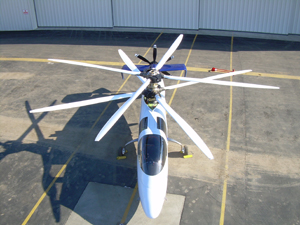Press Release
High-Flying Technology to Be Recognized at Clark School Innovation Hall of Fame Induction Ceremony
Ashish Bagai Honored for Work on Sikorsky X2TD Demonstrator
FOR IMMEDIATE RELEASE October 24, 2012
CONTACT:
Melissa Corley
301 405 6501
mcorley@umd.edu

X2 Image Courtesy of Sikorsky (Hi-res)
COLLEGE PARK, Md.--The innovator behind the rotor blade technology used on the fastest helicopter produced will be inducted into the A. James Clark School of Engineering's Innovation Hall of Fame at the University of Maryland, College Park, on Thursday, November 8, 2012, at 4:30 p.m.
Ashish Bagai, a Clark School aerospace engineering alumnus, is an aerodynamicist. He was principal engineer at Sikorsky Aircraft Corp. in 2010 when a team of Sikorsky engineers built the Sikorsky X2 Technology DemonstratorTM (X2), a helicopter that can fly 100 mph faster than current production models, with increased maneuverability, endurance and high-altitude performance.
The Sikorsky team earned the prestigious Robert J. Collier Trophy--one of aviation’s highest honors--for its innovation. The X2 will, according to the company, change the way helicopters operate, delivering higher speeds and radically improved performance in medical, search and rescue and military applications, while maintaining the efficient hovering and low-speed attributes of conventional rotorary-wing aircraft. Bagai was responsible for the aerodynamic design of the aircraft’s main rotor blades, a key element in its success.
Today, Bagai is a program manager at the Tactical Technology Office of the Defense Advanced Research Projects Agency. He obtained his bachelor’s, master’s and doctoral degrees (’90, ’92, ’95) at the Clark School’s Department of Aerospace Engineering (AE) and worked in the department’s Alfred Gessow Rotorcraft Center. He cites as a primary mentor his advisor, internationally recognized rotorcraft aerodynamics expert and Minta Martin Professor of Engineering J. Gordon Leishman, plus Professors Alfred Gessow, James Baeder, Roberto Celi and Inderjit Chopra.
“I had the privilege of attending one of the finest schools for rotary-wing education and research,” Bagai states. “It brought very significant advantages: use of some of the best research facilities, unlimited access to information, and exposure to and interaction with world-class experts. Faculty members were constantly pushing new areas of research and then rolling their findings into the curriculum. Ultimately, it was the capability of calculated independent thinking fostered by the Clark School that helped lead to the X2 rotor design.”
Meeting the Design Challenge
In September 2010, the X2 flew at a speed of 290 mph (250 knots) in level flight, an unofficial helicopter speed record. Achieving high speed, while maintaining or improving capabilities such as high-altitude flight and maneuverability in confined spaces, was the key objective for the co-axial, pusher-propeller-assisted X2.
"The design problem differs from what is required for a single rotor helicopter or for conventional, articulated coaxial or intermeshing rotors" because the X2 does not require the retreating blades to produce lift at high speeds, Bagai said. "One must design a fundamentally new rotor blade that will achieve speed but also provide hover performance capabilities.”
Characteristics of Bagai’s novel design include non-uniform planaform, positive and negative twist gradients and a complex distribution of modern airfoils and thicknesses. Bagai’s design benefitted from the knowledge gained from many years of related work, as well as many contributions by Sikorsky colleagues.
“I drew on the guidance of exceptional people at Sikorsky, gentlemen who provided years of experience and in-depth understanding and were only too happy to encourage and support the effort," Bagai said.
The Clark School’s Innovation Hall of Fame recognizes innovation at the concept, design or working level of engineering, and the benefits innovation brings to society. Clark School alumni, students, and faculty, as well as other individuals with a strong connection to the Clark School, are eligible for selection.
This year's Innovation Hall of Fame Induction Ceremony will be followed by the 2012 Charles and Helen White Symposium on Engineering Innovation titled "The Impact of Helicopters in Society Today: Search and Rescue, Law Enforcement, and National Defense, with a Special Appearance by the Gamera Human-Powered Helicopter Team." The symposium will take place at 5 p.m. in the rotunda of the Kim Engineering Building on the College Park campus. Both events are open to the public.
More Information:
Innovation Hall of Fame 2012 Induction Ceremony Information
2012 White Symposium on Engineering Innovation
Ashish Bagai, Sikorsky Aircraft Corporation, Stratford, Conn., "Aerodynamic Design of the X2 Technology DemonstratorTM Main Rotor Blade," Proceedings of the 64th Annual Forum of the American Helicopter Society, 2008.
Rotor Blade for a High-Speed Rotary-Wing Aircraft (Patent: US 7,252,479 B2)
About the A. James Clark School of Engineering
The University of Maryland’s A. James Clark School of Engineering is a premier program, ranked among the top 20 in the world. Located just a few miles from Washington, D.C., the Clark School is at the center of a constellation of high-tech companies and federal laboratories, offering students and faculty access to unique professional opportunities.
Our broad spectrum of academic programs, including the world’s only accredited undergraduate fire protection engineering program, is complemented by a vibrant entrepreneurial ecosystem, early hands-on educational experiences, and participation in national and international competitions.
The Clark School is leading research advancements in aerospace, bioengineering, robotics, nanotechnology, disaster resilience, energy and sustainability, and cybersecurity. From the universal product code to satellite radio, SMS text messaging to the implantable insulin pump, our students, faculty, and alumni are engineering life-changing innovations for millions. Learn more at www.eng.umd.edu.